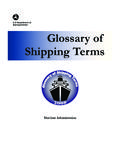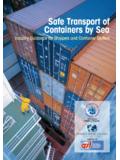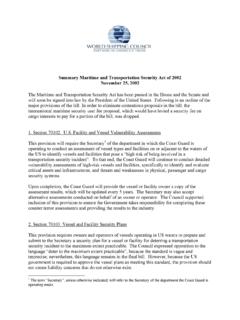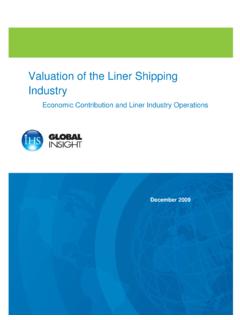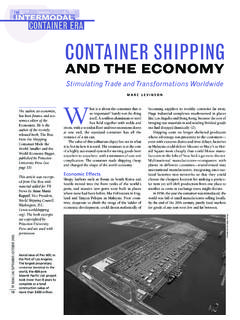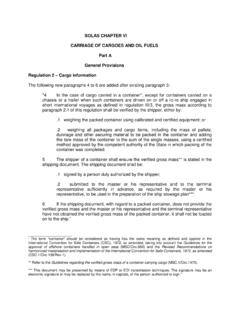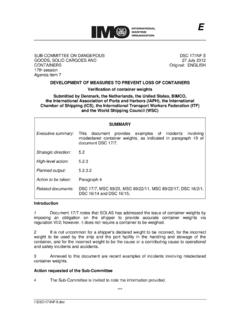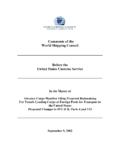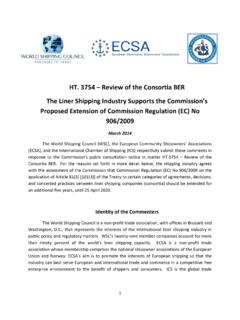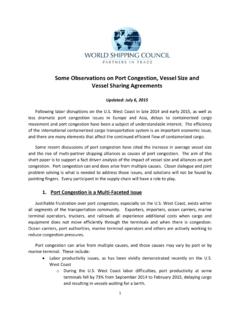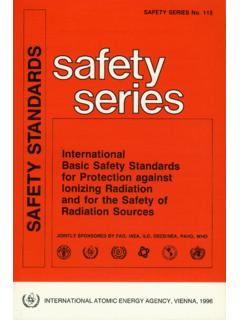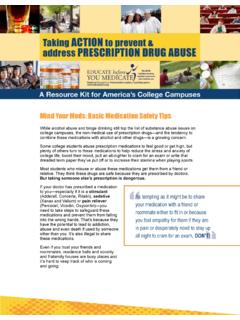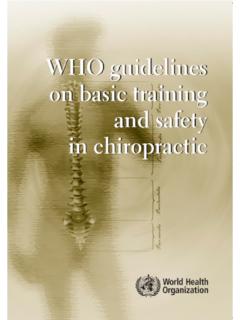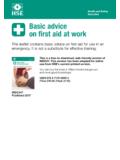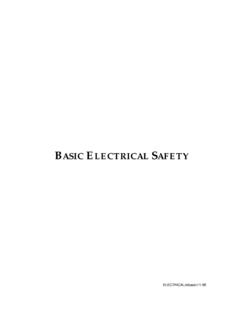Transcription of The SOLAS Container Weight Verification …
1 1 The SOLAS Container Weight Verification Requirement January 2015 The International Maritime Organization (IMO) has amended the safety of Life at Sea Convention ( SOLAS ) to require, as a condition for loading a packed Container onto a ship for export, that the Container has a verified Weight . The shipper is responsible for the Verification of the packed Container s Weight . This requirement will become legally effective on July 1, 2016. After that date, it would be a violation of SOLAS to load a packed Container onto a vessel if the vessel operator and marine terminal operator do not have a verified Container Weight . The SOLAS amendments provide that there are two methods shippers may use to determine the Container Weight once the Container packing process has taken place.
2 This requirement will apply globally. Shippers, freight forwarders, vessel operators, and terminal operators will all need to establish policies and procedures to ensure the implementation of this regulatory change. Because there have been questions about what the specific nature of the SOLAS changes are, the World Shipping Council provides the following basic synopsis of the SOLAS requirement. Basic Principles Under the SOLAS Requirement 1. Before a packed Container can be loaded onto a ship, its Weight must be determined through It is a violation of SOLAS to load a packed Container aboard a vessel 1 In the absence of a shipper providing a verified gross mass of a packed Container , that Container shall not be loaded on to the ship.
3 SOLAS Chapter VI, Regulation 2, paragraph 6. The IMO Guidelines, Section 6, also state: A Container packed with packages and cargo items should not be loaded onto a ship to which the SOLAS regulations apply unless the master or his representative and the terminal representative have obtained, in advance of vessel loading, the verified actual gross mass of the Container . Packed containers for which a verified Weight was provided prior to loading in a preceding load port may be loaded in transshipment ports without having to have their weights re-verified if the port terminal in the transshipment port has been advised of this by the operator of the arriving vessel.
4 2 to which SOLAS applies without a proper Weight Verification . There is no exception to this requirement. 2. Under the SOLAS amendments, there are two permissible methods for weighing: Method 1, which requires weighing the Container after it has been packed, or Method 2,2 which requires weighing all the cargo and contents of the Container and adding those weights to the Container s tare Weight as indicated on the door end of the Container . 3. Estimating Weight is not permitted. The shipper (or by arrangement of the shipper, a third party) has a responsibility to weigh the packed Container or to weigh its contents. Under either Method, the weighing equipment used must meet national certification and calibration requirements.
5 Further, the party packing the Container cannot use the Weight somebody else has provided, except in one specific set of defined 4. A carrier may rely on a shipper s signed Weight Verification to be accurate. The carrier does not need to be a verifier of the shipper s Weight Verification . Nor do the SOLAS amendments require a carrier to verify that a shipper providing a verified Weight according to Method 2 has used a method which has been certified and approved by the competent authority of the jurisdiction in which the packing and sealing of the Container was completed. However, it is important to note that, for the shipper s Weight Verification to be compliant with the SOLAS requirement, it must be signed , meaning a specific person representing the shipper is named and identified as having verified the accuracy of the Weight calculation on behalf of the 2 The IMO Guidelines state that Method 2 would be inappropriate and impractical for certain types of cargo items ( , scrap metal, unbagged grain and other cargo in bulk) that do not easily lend themselves to individual weighing of the items to be packed in the Container .
6 IMO Guidelines, paragraph 3 The one exception is as follows: Individual, original sealed packages that have the accurate mass of the packages and cargo items (including any other material such as packing material and refrigerants inside the packages) clearly and permanently marked on their surfaces, do not need to be weighed again when they are packed into the Container . IMO Guidelines, paragraph This does not permit estimating the cargo Weight , but permits using accurate weights that have been clearly and permanently marked on individual, original sealed packages ( , flat screen TVs that have their Weight ( X kg.) marked by the manufacturer on the box containing the TV).
7 There is no exception for co-loaded containers. The IMO Guidelines are clear that the shipper named on the ocean carrier bill of lading is the party responsible for providing the Container s verified gross mass. IMO Guidelines, paragraph Thus, the master forwarder named on the ocean carrier s bill of lading is responsible for the accurate cargo Weight Verification of all the cargo from all the co-loading forwarders using the Container , and may not simply pass on cargo weights that may have been declared by those other forwarders. 4 The shipping document shall be: .1 signed by a person duly authorized by the shipper; and .2 submitted to the master or his representative.
8 SOLAS Chapter VI, Regulation 2, paragraph 1. This 3 5. The lack of a signed shipper Weight Verification can be remedied by weighing the packed Container at the port. If the marine terminal does not have equipment to weigh the Container and provide a verified Weight , alternative means must be found to obtain a verified Container Weight ; otherwise, the packed Container may not be loaded on to the 6. When a marine terminal receives a packed export Container that does not have a signed shipper Weight Verification , there will need to be processes in place at the terminal for obtaining the Weight of such containers and using such weights in the vessel stow plan.
9 Terminals and carriers will need to agree on how these situations will be handled. 7. If a packed Container is weighed at the load port, that Weight is to be used for vessel stow 8. Vessel stow plans should use verified weights for all packed containers loaded on board. document can be part of the shipping instructions to the shipping company or a separate communication ( , a declaration including a Weight certificate produced by a weigh station).
10 IMO Guidelines, paragraph [T]he document should clearly highlight that the gross mass provided is the verified gross mass as defined in paragraph 3. IMO Guidelines, paragraph 8. Irrespective of its form, the document declaring the verified gross mass of the packed Container should be signed by a person duly authorized by the shipper. The signature may be an electronic signature or may be replaced by the name in capitals of the person authorized to sign it. IMO Guidelines, paragraph 9. 5 If the shipping document, with regard to a packed Container , does not provide the verified gross mass and the master or his representative and the terminal representative have not obtained the verified gross mass of the packed Container , it shall not be loaded on to the ship.
